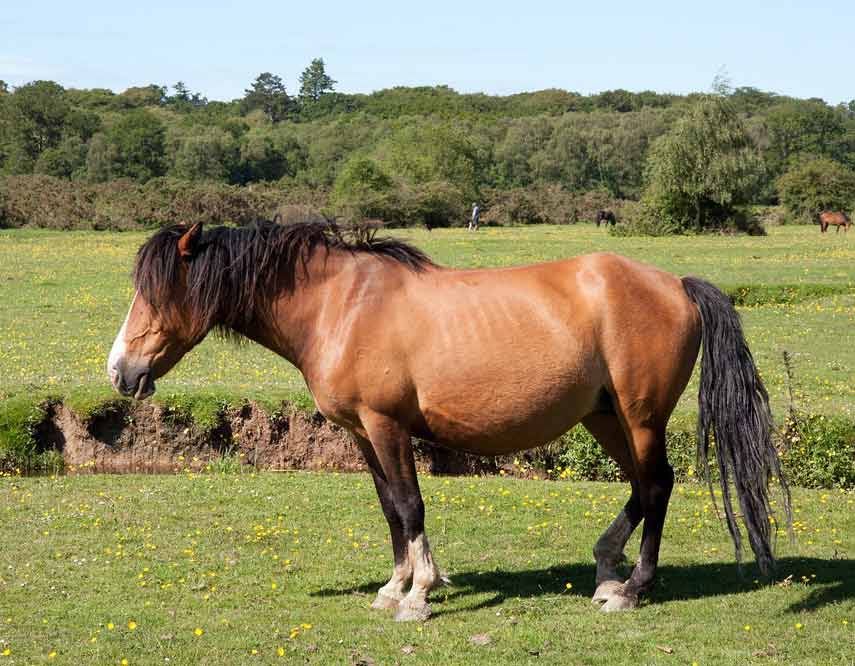The New Forest Pony stands as a testament to the rich equestrian heritage of the British Isles, its origins shrouded in the misty veils of time. This breed, revered for its resilience and adaptability, roams the rugged landscapes of the New Forest, embodying the spirit of untamed beauty. With a history steeped in tradition, it has evolved into an emblem of cultural significance, symbolizing the enduring bond between humans and horses. In this article, I am going to give an overview of the New Forest Pony horse breed profile and description.
New Forest Pony Horse Breed
Legend has it that the New Forest Pony traces its lineage back to ancient times when Celtic tribes first inhabited the verdant woodlands of southern England. These sturdy ponies, bred for their strength and endurance, played a vital role in the daily lives of early settlers, serving as indispensable companions in labor and leisure alike. Over centuries of selective breeding and natural selection, they gradually adapted to their rugged environment, acquiring the distinctive traits that define the breed today.
A Portrait of Resilience and Adaptability
Characterized by their sturdy build and gentle demeanor, New Forest Ponies epitomize the resilience of nature’s finest creations. Their compact frames, adorned with flowing mane and tail, exude an aura of untamed grace, reflecting their harmonious existence within the untamed wilderness. Blessed with an innate intelligence and keen instincts, they navigate the treacherous terrain of the New Forest with effortless ease, embodying the essence of survival against all odds.
Guardians of Biodiversity: Preserving a Living Legacy
In an age marked by rapid urbanization and dwindling habitats, the New Forest Pony stands as a poignant reminder of the importance of biodiversity conservation. As stewards of the land, these majestic creatures play a crucial role in maintaining the delicate balance of ecosystems, their grazing habits shaping the diverse flora and fauna of their native habitat. Through concerted efforts in sustainable management and genetic preservation, conservationists strive to safeguard the future of this iconic breed for generations to come.
Cultivating a Timeless Connection: The Human-Horse Bond
Beyond their intrinsic value as symbols of natural heritage, New Forest Ponies forge profound connections with humans, transcending barriers of language and culture. For centuries, they have served as faithful companions and trusted allies, enriching the lives of equestrians young and old with their unwavering loyalty and unwavering spirit. Whether traversing ancient woodland trails or partaking in competitive equestrian pursuits, these remarkable ponies continue to inspire awe and admiration, their timeless legacy woven into the fabric of human history.

More Interesting Articles
- Gilbert’s Potoroo – Profile | Traits | Facts | habitat | Population
- Striped Grass Mouse – Profile | Traits | Facts | Pet | Habitat | Diet
- Desert Rat Kangaroo – Profile | Traits | Facts | Adaptations | Diet
- Musky Rat-Kangaroo – Profile | Traits | Facts | Habitat | Baby
- Northern Brown Bandicoot – Profile | Traits | Facts | Habitat | Diet
- Grey Dwarf Hamster – Profile | Facts | Traits | Cute | Baby | Lifespan
- European Hamster – Profile | Facts | Traits | Size | Pet | Baby
- Campbell’s Dwarf Hamster – Profile | Facts | Traits | Colors | Size
- Winter White Dwarf Hamster – Profile | Facts | Traits | Color | Eyes | Pet
- Mongolian Hamster – Profile | Facts | Traits | Dwarf | Range | Diet
- Turkish Hamster – Profile | Facts | Traits | Habitat | Diet | Pet
- Romanian Hamster – Profile | Facts | Traits | Diet | Range | Baby
- Syrian Hamster – Profile | Facts | Traits | Size | Color | Cute | Poop
- 19 Different Types of Hedgehogs – Profile | Facts | Traits | Pet
- Four-Toed Hedgehog – Profile | Facts | Traits | Size | Cute | Baby
- European Hedgehog – Profile | Facts | Traits | Size | Pet | Habitat
- Woodland Hedgehog – Profile | Facts | Traits | Baby | Diet | Range
- Northern White-Breasted Hedgehog – Profile | Facts | Traits
- Amur Hedgehog – Profile | Facts | Traits | Distribution | Diet
- Indian Hedgehog – Animal | Profile | Facts | Traits | Protein | Habitat
